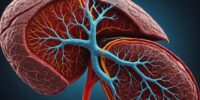Endometriosis And Infertility: Diagnosis And Treatment
Endometriosis is a chronic and debilitating condition affecting millions of women worldwide, characterized by the growth of endometrial-like tissue outside the uterus. One of the significant challenges posed by endometriosis is its association with infertility. Infertility affects approximately 30-50% of women with endometriosis, making it a distressing and emotionally taxing experience for those affected.
The diagnosis and treatment of endometriosis and infertility require a comprehensive and multidisciplinary approach. This article aims to provide an overview of the current understanding of endometriosis and infertility, including the symptoms, diagnostic methods, and available treatment options.
Non-surgical treatments, such as hormonal therapies, will be explored, as well as surgical interventions for more severe cases. Fertility preservation techniques and assisted reproductive technologies will also be discussed. Additionally, managing emotional well-being and implementing lifestyle strategies for coping with the challenges of endometriosis and infertility will be addressed.
Ultimately, this article aims to provide hope and a future outlook for women navigating the complex journey of endometriosis and infertility.
Key Takeaways
- Endometriosis is a chronic condition characterized by the growth of endometrial-like tissue outside the uterus that affects millions of women worldwide.
- Infertility affects 30-50% of women with endometriosis, highlighting the need for comprehensive diagnosis and treatment strategies.
- Diagnosis involves pelvic ultrasound and laparoscopy, while hormone level testing can assess hormonal imbalances.
- Treatment options include non-surgical approaches such as hormonal therapies and pain management strategies, as well as surgical interventions like laparoscopy and in vitro fertilization (IVF) for infertility.
Understanding the Symptoms of Endometriosis
False
Seeking a Medical Evaluation
Seeking a medical evaluation is crucial in order to identify potential underlying causes and determine appropriate courses of action for individuals experiencing reproductive challenges. A comprehensive evaluation typically involves a detailed medical history, physical examination, and various diagnostic tests. These tests may include:
-
Pelvic ultrasound: This diagnostic imaging technique uses sound waves to create images of the pelvic organs, helping to detect any abnormalities or signs of endometriosis.
-
Hormone level testing: Blood tests can measure hormone levels, such as follicle-stimulating hormone (FSH), luteinizing hormone (LH), and estrogen, to assess potential hormonal imbalances that may contribute to infertility.
-
Laparoscopy: This minimally invasive surgical procedure allows for direct visualization of the pelvic organs and the identification and removal of endometrial tissue. It is considered the gold standard for diagnosing endometriosis.
During the medical evaluation, healthcare providers aim to rule out other possible causes of infertility or reproductive challenges, such as hormonal imbalances, structural abnormalities of the reproductive organs, or other medical conditions. By conducting a thorough evaluation, healthcare providers can determine if endometriosis is the underlying cause and develop an individualized treatment plan.
To ensure a successful evaluation, individuals should communicate openly with their healthcare provider, providing accurate and detailed information about their symptoms, medical history, and any previous treatments. A collaborative approach between the patient and healthcare provider is essential in order to achieve an accurate diagnosis and develop an effective treatment strategy.
Exploring Non-Surgical Treatment Options
This discussion will explore non-surgical treatment options for endometriosis, focusing on three key points.
First, hormonal therapy can be used to manage symptoms by regulating hormone levels and reducing the growth of endometrial tissue.
Second, pain management strategies, such as nonsteroidal anti-inflammatory drugs (NSAIDs) and heat therapy, can help alleviate the chronic pelvic pain associated with endometriosis.
Lastly, lifestyle modifications, including regular exercise, a balanced diet, and stress reduction techniques, can support overall health and potentially reduce endometriosis symptoms.
Hormonal Therapy to Manage Symptoms
Hormonal therapy serves as an effective approach in managing the symptoms associated with endometriosis and infertility. The main goal of hormonal therapy is to suppress the production of estrogen, which is responsible for the growth and development of endometrial tissue. By reducing estrogen levels, hormonal therapy can alleviate pain, reduce inflammation, and slow down the progression of the disease.
Common hormonal therapies include:
- Oral contraceptives: They work by regulating the menstrual cycle and decreasing the amount of endometrial tissue that grows outside of the uterus.
- Progestins: They help to thin the lining of the uterus and inhibit the growth of endometrial tissue.
- Gonadotropin-releasing hormone agonists: They suppress the production of estrogen and induce a state of artificial menopause.
Overall, hormonal therapy plays a crucial role in managing the symptoms of endometriosis and infertility by targeting the underlying hormonal imbalance.
Pain Management Strategies
Pain management strategies are crucial in providing relief and improving the quality of life for individuals with endometriosis and associated symptoms.
Nonsteroidal anti-inflammatory drugs (NSAIDs) are commonly used as first-line treatment for pain relief, as they can help reduce inflammation and alleviate pain.
Hormonal therapies, such as oral contraceptives, progestins, and gonadotropin-releasing hormone agonists, are also effective in managing pain associated with endometriosis. These therapies work by suppressing the production of estrogen, which can help reduce the growth of endometrial tissue and alleviate pain.
In addition to medication, non-pharmacological approaches like heat therapy, physical therapy, and relaxation techniques may also be beneficial in managing pain.
It is important for healthcare providers to work closely with patients to develop an individualized pain management plan that addresses their specific needs and preferences.
Lifestyle Modifications to Support Overall Health
Lifestyle modifications play a crucial role in supporting overall health and well-being for individuals with endometriosis. By making certain changes to their daily routines and habits, individuals can potentially alleviate some of the symptoms associated with endometriosis and improve their quality of life. Some key lifestyle modifications that can be beneficial include maintaining a balanced diet, engaging in regular physical activity, managing stress through relaxation techniques, ensuring adequate sleep, and avoiding known triggers such as caffeine and alcohol. These modifications can help individuals with endometriosis manage their pain, reduce inflammation, improve hormonal balance, and support their immune system. Additionally, incorporating alternative therapies such as acupuncture or yoga may also provide additional relief. It is important to note that lifestyle modifications should be personalized and tailored to each individual’s needs, and consultation with healthcare professionals is recommended to ensure the most effective management of endometriosis.
| Lifestyle Modification | Benefits | |||
|---|---|---|---|---|
| Balanced diet | Reduces inflammation and supports hormonal balance | |||
| Regular physical activity | Enhances overall well-being and can reduce pain | |||
| Stress management through relaxation techniques | Decreases stress levels and promotes relaxation | |||
| Adequate sleep | Supports immune system and overall health | |||
| Avoidance of triggers such as caffeine and alcohol | Minimizes symptom exacerbation and inflammation | Regular exercise and physical activity | Improves mood, boosts energy levels, and reduces pain | |
| Healthy diet and nutrition | Supports the body’s natural healing process and reduces inflammation | |||
| Social support and positive relationships | Enhances emotional well-being and provides a sense of belonging | |||
| Mindfulness and meditation practices | Reduces stress, improves focus, and promotes overall mental well-being | |||
| Seeking professional help and therapy | Provides guidance, coping strategies, and support for managing pain and stress | |||
| Engaging in hobbies and activities that bring joy | Promotes a sense of fulfillment and distraction from pain and stress | |||
| Setting realistic goals and managing expectations | Reduces pressure and promotes a positive mindset | |||
| Using relaxation techniques such as deep breathing and progressive muscle relaxation | Relieves muscle tension, reduces stress, and promotes relaxation | |||
| Incorporating self-care activities into daily routine | Promotes self-nurturing and reduces stress | |||
| Engaging in activities that promote laughter and humor | Releases endorphins, reduces stress, and improves overall well-being | |||
| Practicing good time management and prioritization skills | Reduces stress and promotes a sense of control | |||
| Seeking support from support groups or online communities | Provides a sense of belonging, understanding, and shared experiences | |||
| Engaging in creative outlets such as art or music therapy | Provides a means of self-expression, reduces stress, and promotes relaxation | |||
| Practicing gratitude and positive thinking | Improves overall mindset and reduces stress | |||
| Engaging in regular self-reflection and introspection | Promotes self-awareness, emotional well-being, and stress reduction | |||
| Taking breaks and rest periods throughout the day | Helps prevent fatigue and reduces stress | |||
| Engaging in regular massage therapy or other bodywork techniques | Reduces muscle tension, promotes relaxation, and decreases pain | |||
| Practicing good posture and ergonomics | Reduces strain on the body and minimizes pain | |||
| Using heat or cold therapy for pain relief | Reduces inflammation and provides temporary pain relief | |||
| Using assistive devices or adaptive equipment as needed | Helps manage pain and reduces physical strain | |||
| Avoiding overexertion and pacing oneself | Prevents exacerbation of symptoms and reduces fatigue | |||
| Engaging in activities that promote relaxation and stress reduction before bedtime | Improves sleep quality and promotes overall well-being | |||
| Creating a comfortable sleep environment | Enhances sleep quality and promotes restfulness | |||
| Seeking treatment for underlying medical conditions or chronic pain | Helps manage symptoms and reduces overall pain levels | |||
| Practicing deep breathing exercises or guided imagery | Reduces stress, promotes relaxation, and minimizes pain | |||
| Engaging in regular physical therapy or rehabilitation exercises | Helps manage pain, improves mobility, and promotes overall well-being | |||
| Using distraction techniques such as listening to music or engaging in hobbies | Shifts focus away from pain and reduces stress | |||
| Developing a consistent sleep routine | Improves sleep quality and promotes overall well-being | |||
| Using relaxation techniques such as aromatherapy or herbal remedies | Promotes relaxation and reduces stress | |||
| Practicing mindfulness-based stress reduction techniques | Reduces stress and improves overall well-being | |||
| Seeking support from loved ones and communicating openly about pain and stress | Provides emotional support and reduces feelings of isolation |
Considering Surgical Intervention
Surgical intervention serves as a crucial option to address the complex relationship between endometriosis and infertility, offering hope to individuals longing for the possibility of conceiving a child.
Laparoscopy, a minimally invasive surgical procedure, is commonly used to diagnose and treat endometriosis-related infertility. Through this procedure, endometrial tissue can be visualized and removed, reducing inflammation and restoring normal pelvic anatomy.
In cases where endometriosis is severe, more extensive surgery, such as laparotomy or robotic-assisted laparoscopy, may be necessary. These procedures aim to remove deep infiltrating endometriosis, excise endometriomas, and reconstruct damaged reproductive organs.
Surgical intervention not only helps improve fertility outcomes but also alleviates pain associated with endometriosis. However, it is important to note that surgery alone may not guarantee pregnancy success, and in some cases, assisted reproductive techniques may be needed in conjunction with surgical intervention to achieve the desired outcome.
Fertility Preservation and Assisted Reproductive Technologies
This discussion focuses on the role of fertility preservation and assisted reproductive technologies in the context of endometriosis and infertility.
One key aspect is egg freezing, which allows women with endometriosis to preserve their fertility for future use.
In addition, in vitro fertilization (IVF) plays a crucial role in overcoming infertility associated with endometriosis by facilitating the fertilization of eggs outside the body and transferring them to the uterus.
Egg Freezing for Future Fertility
Egg freezing, a method to preserve fertility for women with endometriosis, offers the opportunity to delay childbearing and increase the chances of successful pregnancy in the future. It involves the extraction and freezing of a woman’s eggs, which can be stored for several years until she is ready to conceive.
This technique is particularly beneficial for women with endometriosis, as this condition can negatively impact ovarian reserve and quality of eggs. By freezing eggs at a younger age, women with endometriosis can ensure the availability of healthier eggs when they decide to start a family.
Additionally, egg freezing can provide psychological relief for women with endometriosis who may worry about their ability to conceive in the future. However, it is important to note that the success rates of egg freezing vary depending on various factors, including age and the number of eggs frozen.
Therefore, it is crucial for women with endometriosis to consult with a fertility specialist to discuss their individual circumstances and options.
In Vitro Fertilization (IVF) and Endometriosis
One common approach for addressing the impact of endometriosis on fertility involves utilizing in vitro fertilization (IVF) to increase the chances of successful conception and pregnancy.
IVF is a technique that involves retrieving eggs from the ovaries and fertilizing them with sperm in a laboratory setting. The resulting embryos are then transferred back into the uterus in the hopes of achieving pregnancy.
IVF can be particularly beneficial for women with endometriosis as it bypasses the potential barriers to conception caused by the condition, such as blocked fallopian tubes or impaired egg quality. Additionally, IVF allows for the selection of high-quality embryos, increasing the chances of a successful pregnancy.
While IVF may not be a guaranteed solution, it offers a viable option for couples struggling with infertility due to endometriosis.
Managing Emotional Well-being
Coping with the emotional challenges associated with endometriosis and infertility requires a comprehensive approach that addresses the psychological well-being of individuals affected by these conditions. The impact of endometriosis and infertility on mental health can be significant, leading to feelings of sadness, frustration, and anxiety. It is crucial for individuals to have access to support networks, such as therapists or support groups, to help them navigate through these emotions. Additionally, practicing self-care techniques, such as mindfulness exercises and stress management strategies, can aid in managing emotional well-being. Engaging in activities that bring joy and fulfillment, maintaining a healthy lifestyle, and seeking professional help when needed are essential components of managing emotional well-being throughout the journey of endometriosis and infertility.
| Strategies for Managing Emotional Well-being |
|---|
| Seek professional help |
| Join support groups |
| Practice self-care techniques |
| Engage in activities that bring joy |
| Maintain a healthy lifestyle |
Lifestyle Strategies for Managing Endometriosis and Infertility
This paragraph will discuss lifestyle strategies for managing endometriosis and infertility. Specifically, it will focus on diet and nutrition recommendations, exercise and physical activity, and stress management techniques. These strategies are important for individuals dealing with these conditions, as they can potentially improve symptoms and overall well-being.
By following appropriate dietary guidelines, engaging in regular exercise, and implementing stress management techniques, individuals can potentially enhance their quality of life while managing endometriosis and infertility.
Diet and Nutrition Recommendations
To effectively manage the symptoms of endometriosis and potentially improve fertility outcomes, it is crucial to adopt a well-balanced and nutrient-rich diet. A diet that is rich in fruits, vegetables, whole grains, lean proteins, and healthy fats can provide the necessary nutrients to support overall health and potentially reduce inflammation associated with endometriosis.
Specifically, incorporating foods high in omega-3 fatty acids, such as fatty fish, flaxseed, and walnuts, may help reduce inflammation and alleviate symptoms. Additionally, consuming foods rich in antioxidants, such as berries, dark leafy greens, and green tea, can help combat oxidative stress and promote a healthy reproductive system.
It is also important to limit the intake of processed foods, refined sugars, and saturated fats, as these can contribute to inflammation and worsen symptoms. Consulting with a healthcare professional or registered dietitian can provide personalized dietary recommendations for individuals with endometriosis and infertility.
Exercise and Physical Activity
Engaging in regular exercise and physical activity has been shown to have potential benefits for individuals managing endometriosis and seeking to improve fertility outcomes. Exercise can help manage symptoms associated with endometriosis, such as pain and fatigue, by increasing blood flow and reducing inflammation.
Additionally, physical activity can help maintain a healthy body weight, which is important for hormonal balance and reproductive health.
To maximize the benefits of exercise for endometriosis and fertility, individuals should consider the following:
-
Low-impact exercises: Opt for activities like swimming, cycling, or walking to minimize stress on the joints and pelvic area.
-
Strength training: Incorporate strength training exercises to improve muscle tone, support the pelvic region, and enhance overall physical well-being.
-
Mind-body exercises: Practices like yoga and Pilates can help reduce stress and improve mental well-being, which can positively impact fertility.
-
Moderation and consistency: Engage in regular exercise routines that are moderate in intensity and frequency to avoid overexertion and maintain a balanced approach to physical activity.
By incorporating these exercise recommendations, individuals with endometriosis can potentially improve their overall well-being and increase their chances of achieving successful fertility outcomes.
Stress Management Techniques
Incorporating stress management techniques can be beneficial for individuals seeking to optimize their overall well-being and increase their chances of achieving successful fertility outcomes. Stress has been linked to various negative effects on reproductive health, including impairments in ovulation, implantation, and pregnancy maintenance. Therefore, implementing effective stress management techniques may help mitigate these detrimental effects.
Some commonly utilized techniques include:
- Meditation
- Deep breathing exercises
- Yoga
- Mindfulness-based stress reduction
These techniques aim to promote relaxation, reduce anxiety, and improve overall mental well-being. It is important to note that stress management techniques should be used in conjunction with other evidence-based treatments for endometriosis and infertility. Additionally, individuals should consult with healthcare professionals to determine the most appropriate stress management techniques for their specific circumstances.
Overall, stress management techniques can play a valuable role in optimizing fertility outcomes for those with endometriosis.
Hope and Future Outlook
Looking ahead, there is a promising future for individuals with endometriosis-related infertility as advancements in diagnosis and treatment continue to evolve. With ongoing research and technological advancements, the landscape of endometriosis management is gradually changing. Here are some key developments that offer hope for the future:
-
Improved diagnostic tools: Innovative imaging techniques, such as magnetic resonance imaging (MRI) and transvaginal ultrasound, are being refined to enhance the accuracy and efficiency of endometriosis diagnosis.
-
Personalized treatment approaches: Tailored treatment plans based on a patient’s specific condition and needs are being explored. This individualized approach aims to optimize outcomes and minimize the impact of infertility caused by endometriosis.
-
Emerging therapies: Novel therapeutic options, such as targeted drug delivery systems, immunomodulatory agents, and gene therapies, are being investigated to address the underlying mechanisms of endometriosis and improve fertility outcomes.
-
Multidisciplinary collaboration: Collaboration between gynecologists, reproductive endocrinologists, pain specialists, and mental health professionals is becoming increasingly important. This holistic approach ensures comprehensive care for individuals with endometriosis-related infertility.
As research progresses and technologies advance, the future holds promise for improved diagnosis, personalized treatment, and enhanced fertility outcomes for individuals affected by endometriosis-related infertility.
Frequently Asked Questions
Can endometriosis be diagnosed through a blood test?
Endometriosis cannot be diagnosed through a blood test alone. Diagnosis requires a combination of medical history, physical examination, imaging techniques, and, in some cases, laparoscopic surgery with histological confirmation of the presence of endometrial tissue outside the uterus.
Are there any natural remedies or alternative therapies that can help manage endometriosis and improve fertility?
There is limited scientific evidence to support the effectiveness of natural remedies or alternative therapies in managing endometriosis and improving fertility. Further research is needed to evaluate their safety and efficacy.
What are the potential risks and complications associated with surgical intervention for endometriosis?
The potential risks and complications associated with surgical intervention for endometriosis include infection, bleeding, damage to surrounding organs, formation of scar tissue, and potential recurrence of endometriosis lesions.
How long does it typically take for fertility to improve after undergoing surgical treatment for endometriosis?
Fertility improvement after surgical treatment for endometriosis varies, with some studies reporting a positive effect within 6-12 months, while others suggest a longer time frame. Individual factors such as age and severity of endometriosis may also influence the timeline.
Are there any specific dietary recommendations for women with endometriosis to improve fertility outcomes?
There are no specific dietary recommendations for women with endometriosis to improve fertility outcomes. However, maintaining a balanced diet, managing weight, and incorporating regular exercise may have positive effects on overall health and potentially improve fertility.







